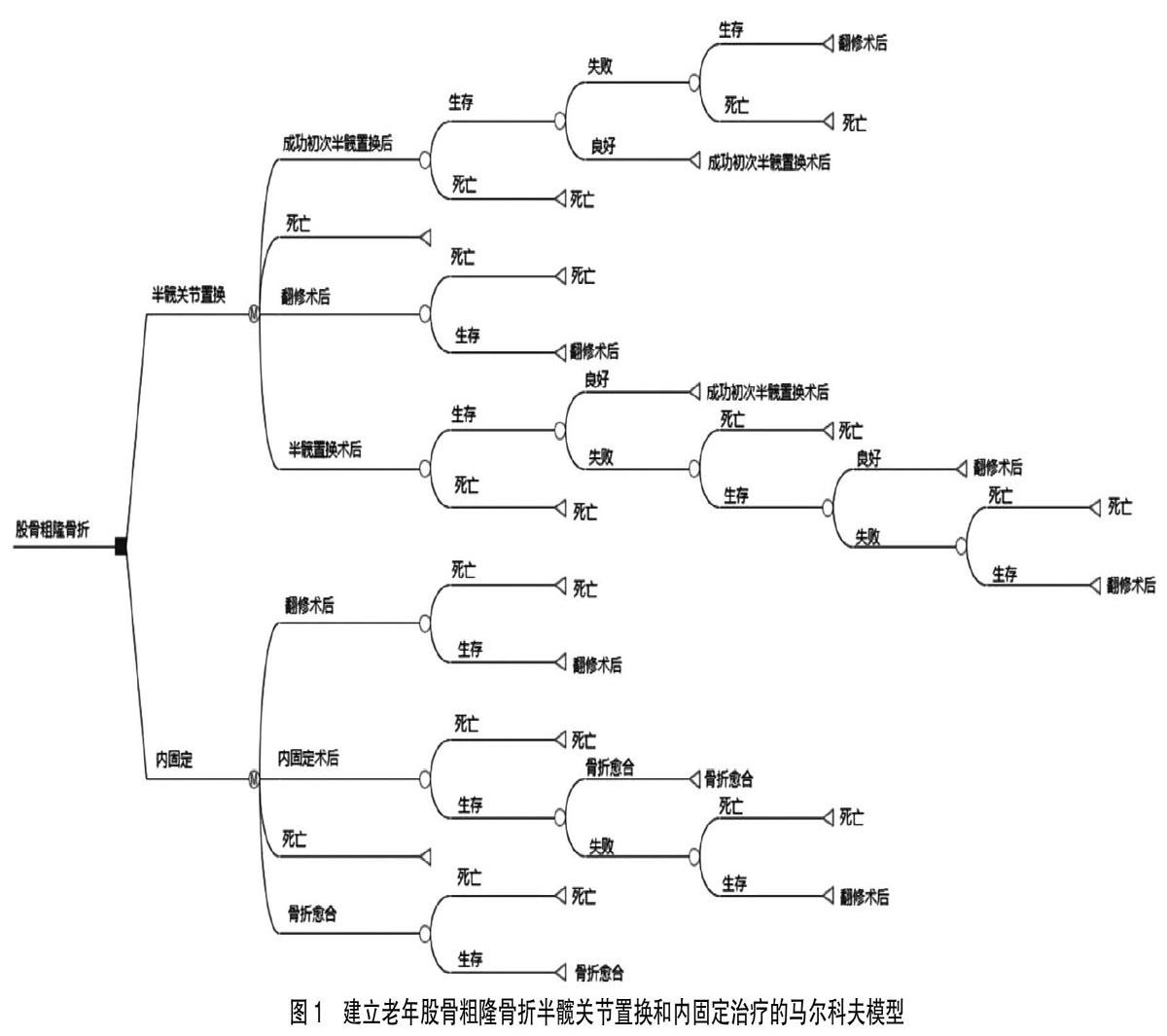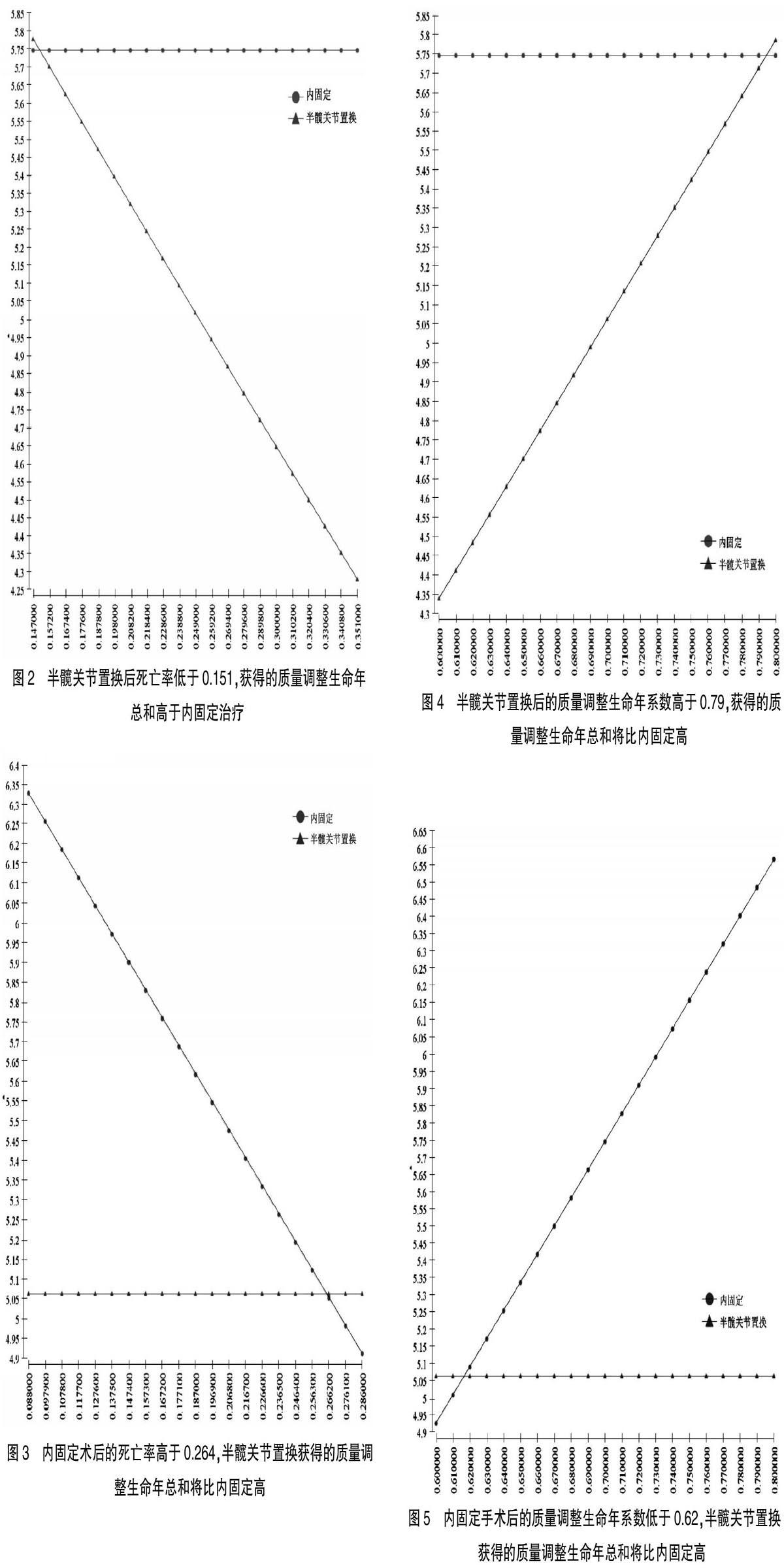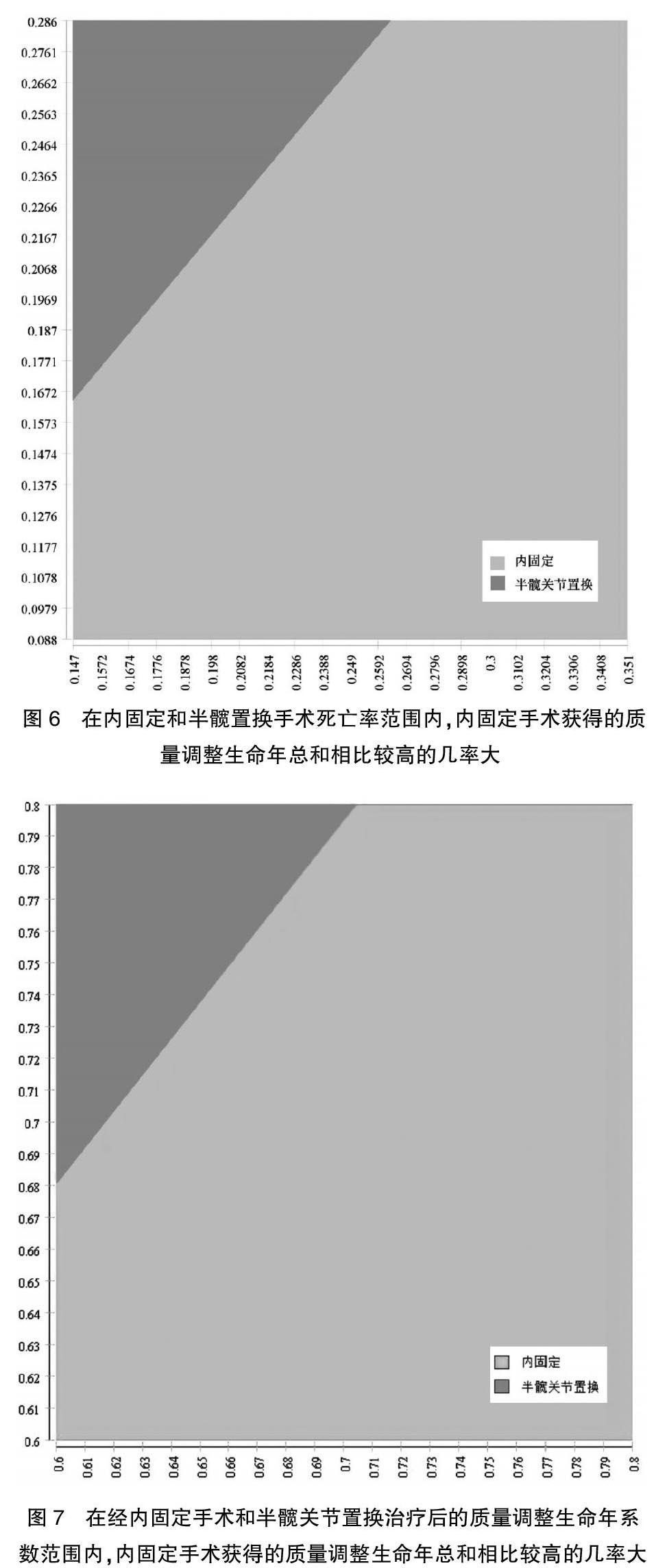马尔科夫模型下内固定和半髋关节置换治疗骨质疏松性股骨粗隆骨折的质量调整生命年的比较研究
2019-08-15吴剑彬杨雷王逸扬汤骏冯永增
吴剑彬 杨雷 王逸扬 汤骏 冯永增



[摘要] 目的 比較内固定和半髋关节置换治疗老年骨质疏松性股骨粗隆骨折获得的质量调整生命年的总和,为治疗方法的决策制定和经济效益分析提供依据。 方法 时间跨度设定为10年,既从2018~2028年,建立内固定和半髋关节置换治疗老年股骨粗隆骨折马尔科夫模型。对数个数据库进行检索,纳入比较内固定和半髋关节置换治疗老年股骨粗隆骨折的研究,提取模型所需要的临床结果概率数据。利用决策软件计算两种治疗方法获得的质量调整生命年总和,并对结果进行敏感度分析。 结果 老年股骨粗隆骨折患者接受半髋关节置换手术10年后获得的质量调整生命年总和为5.062年,接收内固定治疗10年后获得的质量调整生命年总和为5.745年。患者经内固定治疗比经半髋关节置换获得的质量调整生命年多。单因素和双因素敏感度分析支持模型结果。 结论 在预期10年寿命的患者中,半髋关节置换与内固定治疗相比不具备优势。老年股骨粗隆骨折患者经半髋关节置换治疗后的质量调整生命年系数需达到0.8,获得的质量调整生命年总和才会比内固定治疗高。
[关键词] 股骨粗隆骨折;内固定;髋关节置换;半髋关节置换;质量调整生命年;经济效益分析
[中图分类号] R687.3 [文献标识码] B [文章编号] 1673-9701(2019)16-0063-07
[Abstract] Objective To compare the sum of quality-adjusted life years obtained by internal fixation and hemiarthroplasty in the treatment of senile osteoporotic femoral trochanteric fractures, and to provide a basis for decision-making and economic benefit analysis of treatment methods. Methods The time span was set to 10 years, from 2018 to 2028, to establish a Markov model for the treatment of elderly femoral trochanteric fractures with internal fixation and hemiarthroplasty. Several databases were searched for the study of internal fixation and hemiarthroplasty for the treatment of elderly femoral trochanteric fractures, and the required clinical outcome probability data were extracted. The decision-making software was used to calculate the sum of the quality-adjusted life years obtained by the two treatment methods, and the results were analyzed for sensitivity. Results In the elderly patients with femoral trochanteric fractures, the total quality-adjusted life years obtained after 10 years of hemiarthroplasty were 5.062 years, and the total quality-adjusted life years obtained after receiving internal fixation for 10 years was 5.745 years. Patients undergoing internal fixation got more quality-adjusted life years than those undergoing hemiarthroplasty. Single factor and two factor sensitivity analysis supported the model results. Conclusion Among patients with a 10-year life expectancy, hemiarthroplasty has no advantage over internal fixation. In patients with old femoral trochanteric fractures, the quality-adjusted life-year coefficient after treatment with hemiarthroplasty needs to be 0.8 when the sum of quality-adjusted life years obtained will be higher than that of internal fixation.
[Key words] Femoral trochanteric fracture; Internal fixation; Hip replacement; Hemiarthroplasty; Quality-adjusted life year; Economic benefit analysis
髋部骨折是老年人群中常见且严重的外伤,发生骨折后患者常常面临高死亡率和高致残率的风险[1-3]。文献中报道在髋部骨折中,股骨粗隆骨折的发生率高于股骨颈骨折[4]。老年移位股骨颈骨折通常行关节置换进行治疗,由于可以早期负重活动,术后往往可以获得良好的生活质量[5,6]。与股骨颈骨折不同,股骨粗隆骨折一般采用内固定的方式进行治疗,治疗的预后有时难以预测。由于术后需要一段限制负重时间以等待骨折愈合,老年股骨粗隆骨折患者术后的行走能力往往会比受伤前降低一个等级[7-9]。
近几年,有数位作者提倡使用关节置换治疗老年不稳定型股骨粗隆骨折[10]。虽然早期的非对比研究提示关节置换可以获得优良结果,但是近年来的回顾性比较研究、前瞻性比较研究,甚至是随机对照研究未提示关节置换与内固定相比,在治疗老年股骨粗隆骨折时的显著优势[11]。在对比关节置换和内固定术后的功能方面,最近的几项荟萃分析显示出相悖的结果[12,13]。
随着我国人均寿命不断延长,老年性骨质疏松已经不单纯是医学问题,更是社会问题。髋部骨折是老年性骨质疏松最严重的并发症,其发生率在逐年上升,是社会保障系统的沉重负担[14,15]。质量调整生命年(Quality-adjusted life year)是经济效益分析的一项重要指标。本研究针对内固定和关节置换治疗股骨粗隆骨折,分别建立马尔科夫模型,计算并比较在预期寿命内,两种方法获得的质量调整生命年。
1 资料与方法
1.1 研究设计
1.1.1 研究目标人群设定 本实验将年龄为70岁的老年股骨粗隆骨折患者人群作为目标人群。选择这个年龄是因为根据文献报道,此年龄组的股骨粗隆骨折患者可以选择内固定进行治疗,也可以选择半髋置换进行治疗。根据预期寿命,我们将模型的时间跨度设定为10年,既从2018~2028年。
1.1.2 模型设计 本实验对内固定和半髋置换治疗老年股骨粗隆骨折建立马尔科夫模型(图1)。老年股骨粗隆骨折患者经过半髋置换后最终会转入3种健康状态,分别是:(1)成功初次半髋置换后;(2)翻修术后;(3)死亡。半髋置换术后是一项临时状态,代表初次半髋置换手术后,所有经半髋置换治疗的患者都从这个状态开始。本实验假定老年股骨粗隆骨折患者,经过半髋置换手术治疗后可能会发生脱位、深部感染或大转子骨折块不愈合,需进行翻修手术。最多经过两次翻修手术,患者会进入成功初次半髋置换后、翻修术后和死亡3种健康状态。老年股骨粗隆骨折患者經过内固定治疗后最终会转入3种健康状态,分别是:(1)骨折愈合;(2)翻修术后;(3)死亡。内固定术后是一项临时状态,所有经过内固定治疗的患者都从这个状态开始。本实验假定,老年股骨粗隆骨折患者经过内固定手术治疗后可能会发生骨折不愈合、内固定失败或深部感染,需翻修手术治疗。最终患者会进入骨折愈合、翻修术后和死亡状态。死亡是吸收状态,进入这个状态的患者不会向其他状态转变。
1.2 实验参数设定
1.2.1 质量调整生命年系数设定 根据文献回顾,股骨粗隆骨折经过内固定治疗,没有并发症发生并骨折愈合后,患者的质量调整生命年系数为0.6~0.8,本实验将经过内固定治疗的老年股骨粗隆骨折患者的参考病例的质量调整生命年系数设定为0.7[16,17]。文献中没有报道过老年股骨粗隆骨折经过半髋关节置换后的质量调整生命年系数。一项随机对照研究利用EQ-5D表比较了老年股骨粗隆骨折经内固定手术和半髋置换手术后的健康相关生活质量,这项研究表明,治疗1年后两组患者的健康相关生活质量统计上没有显著差异[18]。有一项荟萃分析表明,经关节置换后的老年股骨粗隆骨折患者获得的功能结果要好于经内固定治疗的患者[12]。另一项荟萃分析则报道,经内固定手术治疗的患者获得的功能结果好于关节置换的患者[13]。综合文献所述,本实验假设老年股骨粗隆骨折患者经过半髋关节置换后的质量调整生命年系数与经内固定治疗后一致。
1.2.2 临床结果概率设定 本实验使用如下主题词和关键词组合,在Pubmed、Embase和Cochrane数据库中对比较内固定和半髋置换治疗老年股骨粗隆骨折的文献进行检索:hip fractures、hip* fractures、intertro-chanteric fractures、subtrochanteric fractures、trochanteric fractures、pertrochanteric fractures、peritrochanteric fractures、femur fractures、femoral fractures、acetabul* fractures、arthroplasty,internal fixators、bone screws、bone plates、bone nails、pin*、nail*、screw*、plate*、arthroplasty*、prosthes*。检索时没有语言限制,检索时间为2009年1月1日~2018年12月31日。手工检索入选研究的参考文献。
经过检索和阅读,本实验纳入了9项比较半髋置换和内固定治疗老年骨质疏松性股骨粗隆骨折的对照研究[10,19-26]。经过数据提取和整合,从这些纳入的研究中提取了如下结果概率数据:(1)内固定手术后1年内死亡率为0.169,范围0.088~0.286;(2)半髋置换手术后1年内死亡率为0.243,范围0.147~0.351;(3)内固定手术后因骨折不愈合、内固定失败或深部感染的翻修率为0.080,范围0.038~0.158;(4)半髋手术后因关节脱位、股骨大粗隆不愈合或深部感染的翻修率为0.049,范围0~0.121。本实验假设翻修手术后1年内死亡率与初次手术后1年内死亡率相等,翻修手术后患者质量调整生命年系数将比初次手术后下降10%。本实验依据国家统计局2010年的人口普查统计结果设定老年人群非股骨粗隆骨折导致的年度自然死亡率。
由于文献中没有报道老年股骨粗隆骨折半髋关节置换术后关节假体的长期生存数据,本实验引用瑞士关节成形注册组织(Swedish Arthroplasty Register)的数据来设定老年股骨粗隆骨折成功半髋关节置换术后,需翻修成全髋关节置换的年度概率[27]。同样,本实验引用瑞士关节成形注册组织的数据来设定全髋关节置换术后的年度翻修概率。
1.3 分析
1.3.1 决策分析软件 本实验使用决策分析软件TreeAge Pro建立内固定和半髋关节置换治疗老年股骨粗隆骨折的马尔科夫模型(TreeAge Pro 2011,Williamstown, Massachusetts),计算经过10年后,经两种方法治疗的患者获得的质量调整生命年总和。
1.3.2 敏感性分析 本实验在以下临床结果概率范围内对实验结果进行单因素敏感度分析:(1)内固定手术后死亡率;(2)半髋关节置换后死亡率;(3)初次内固定手术后翻修率;(4)初次半髋关节置换后翻修率;(5)经内固定治疗后的质量调整生命年系数;(6)经半髋关节置换后的质量调整生命年系数。本实验在以下临床结果概率范围内对实验结果进行双因素敏感度分析:(1)内固定手术后死亡率和半髋关节置换后死亡率;(2)初次内固定手术后翻修率和初次半髋关节置换手术后翻修率;(3)经内固定治疗后和经半髋关节置换后的质量调整生命年系数。
2 结果
2.1 目标人群的质量调整生命年结果
本实验结果表明,老年股骨粗隆骨折患者接受半髋关节置换手术治疗,10年后获得的质量调整生命年总和为5.062年。老年股骨粗隆骨折患者接受内固定治疗,10年后获得的质量调整生命年总和为5.745年。患者经过内固定治疗获得的质量调整生命年要比经半髋关节置换获得的质量调整生命年多。
2.2 单因素敏感度分析
单因素敏感度分析结果表明:(1)老年股骨粗隆骨折患者接受半髋关节置换后的死亡率如果低于0.151,半髋关节置换获得的质量调整生命年总和将比内固定高(图2);(2)老年股骨粗隆骨折患者接受内固定手术后的死亡率如果高于0.264,半髋关节置换获得的质量调整生命年总和将比内固定高(图3);(3)在初次半髋关节置换手术翻修率和初次内固定手术翻修率范围内,内固定治疗获得的质量调整生命年总和总是比半髋关节置换高;(4)如果老年股骨粗隆骨折患者接受半髋关节置换后的质量调整生命年系数高于0.79,10年后获得的质量调整生命年总和将比内固定高(图4);(5)如果患者接收内固定手术后的质量调整生命年系數低于0.62,10年后半髋关节置换获得的质量调整生命年总和将比内固定高(图5)。
2.3 双因素敏感性分析
双因素敏感度分析结果表明:(1)在内固定和半髋置换手术死亡率范围内,内固定手术获得的质量调整生命年总和相比较高的几率大(图6);(2)在初次内固定手术翻修率和初次半髋置换手术翻修率范围内,内固定手术获得的质量调整生命年总和都会比半髋关节置换高;(3)在经内固定手术和半髋关节置换治疗后的质量调整生命年系数范围内,内固定手术获得的质量调整生命年总和相比较高的几率大(图7)。
3 讨论
髋部骨折是老年性骨质疏松症的严重并发症[28-30]。不同于腕部骨质疏松性骨折和腰椎的压缩性骨折,老年人发生髋部骨折后经卧床保守治疗的死亡率和致残率较高,手术治疗对于髋部骨折是必要的[2,31]。文献中报道,在髋部骨折中,股骨粗隆骨折的发生率高于股骨颈骨折[4,32]。以往,内固定被认为是治疗股骨粗隆骨折的标准方法[33,34]。移位的老年股骨颈骨折通常给予关节置换治疗,术后患者即可负重行走[35,36]。与股骨颈骨折不同,内固定手术后需伤肢避免负重直至骨折愈合,围手术期患者死亡率高,且内固定治疗有发生固定失败的风险,因此这些患者预后比较难预测[37]。过去数年,有多项文献报道使用关节置换治疗股骨粗隆骨折,这些报道提出股骨粗隆骨折患者髋关节置换后可以早期负重活动,避免骨折端间压缩,可以获得良好的功能[11]。但也有研究提出,与内固定治疗股骨粗隆骨折相比,关节置换没有明显优势[18]。而且关节置换的治疗费用要高于内固定手术。
由于我国人均寿命的不断提高,骨质疏松性骨折发生率逐年上升,已经成为社会保障系统的沉重负担。老年股骨粗隆骨折已经成为社会问题,而不单纯是医学问题。在选择治疗老年股骨粗隆骨折的治疗方法时,必须考虑到经济效益问题。质量调整生命年是对不同治疗方法进行经济效益比较的一项重要指标。目前文献中还没有对老年股骨粗隆骨折经内固定和半髋关节置换治疗后获得的质量调整生命年进行比较的报道。因此,本实验利用决策软件,建立老年股骨粗隆骨折经内固定手术和半髋关节置换手术治疗的马尔科夫模型,计算手术后10年,患者可以获得的质量调整生命年总和,为这两种方法治疗股骨粗隆骨折的选择提供重要依据。
本实验结果提示,老年股骨粗隆骨折患者接受半髋关节置换手术治疗,10年后获得的质量调整生命年总和为5.062年。老年股骨粗隆骨折患者接受内固定治疗,10年后获得的质量调整生命年总和为5.745年。患者经过内固定治疗获得的质量调整生命年要比经半髋关节置换获得的质量调整生命年多。本实验对研究中的参数进行敏感性分析。单因素敏感性分析提示,实验结果不会随初次内固定和半髋关节置换手术后翻修率改变发生变化。实验结果会随内固定手术后和半髋关节置换手术后死亡率变化发生变化,但内固定手术后死亡率需达到0.264或半髋关节置换手术后死亡率需低于0.151,这已经分别接近内固定手术后死亡率和半髋关节置换手术后死亡率的上限和下限。单因素敏感性分析还提示,实验结果会随内固定手术后和半髋关节置换手术后质量调整生命年系数改变发生变化,但内固定手术后质量调整生命年系数需低于0.62或半髋关节置换手术后质量调整生命年系数需高于0.79,这也已经分别接近内固定手术后质量调整生命年系数和半髋关节置换手术后质量调整生命年系数的下限和上限。双因素敏感性分析也支持本实验的结果,理论范围内,在两个参数同时变化的情况下,内固定治疗老年股骨粗隆骨折比半髋关节置换治疗获得更多质量调整生命年的可能性更大。
本实验是首次在决策分析软件上建立内固定和半髋关节置换治疗老年股骨粗隆骨折的马尔科夫模型,计算治疗后获得的质量调整生命年的总和。本实验使用多个主题词和关键词组合对数个数据库进行检索,纳入多项比较内固定和半髋关节置换治疗老年股骨粗隆骨折的对照研究,取得关键临床结果概率数据。本实验也有不足,文献中没有报道老年股骨粗隆骨折患者經过半髋关节置换后的质量调整生命年系数。根据一项利用EQ-5D量表比较两种治疗方法获得的健康相关生活质量的随机对照研究结果,结合几项荟萃分析结果,本实验将内固定和半髋关节置换获得的质量调整生命年系数设定为相同,并在实验中对结果的可靠性进行单因素和双因素敏感性分析。
本次通过建立马尔科夫模型,计算并比较内固定和半髋关节置换治疗老年股骨粗隆骨折获得的质量调整生命年总和的实验表明,在预期10年寿命的患者中,半髋关节置换与内固定治疗相比不具备优势。老年股骨粗隆骨折患者经半髋关节置换治疗后的质量调整生命年系数需达到0.8,获得的质量调整生命年总和才会比内固定治疗高。本实验的结果将为老年股骨粗隆骨折治疗的临床决策及经济效益分析提供重要依据。
[参考文献]
[1] Von Friesendorff M,McGuigan FE,Wizert A,et al. Hip fracture,mortality risk,and cause of death over two decades[J]. Osteoporos Int,2016,27(10):2945-2953.
[2] Van de Ree CLP,De Jongh MAC,Peeters CMM,et al. Hip fractures in elderly people:Surgery or no surgery? A Systematic Review and Meta-Analysis[J]. Geriatric orthopaedic surgery & rehabilitation,2017,8(3):173-180.
[3] Tucker A,Warnock M,McDonald S,et al. Fatigue failure of the cephalomedullary nail:Revision options,outcomes and review of the literature[J]. European Journal of Orthopaedic Surgery & Traumatology:Orthopedie Traumatologie,2018,28(3):511-520.
[4] Friedman SM,Mendelson DA. Epidemiology of fragility fractures[J]. Clinics in Geriatric Medicine,2014,30(2):175-181.
[5] Wang Z,Bhattacharyya T. Outcomes of hemiarthroplasty and total hip arthroplasty for femoral neck fracture:A medicare cohort study[J]. J Orthop Trauma,2017,31(5):260-263.
[6] Ye CY,Liu A,Xu MY,et al. Arthroplasty versus internal fixation for displaced intracapsular femoral neck fracture in the elderly:Systematic review and meta-analysis of short-and long-term effectiveness[J]. Chin Med J (Engl),2016,129(21):2630-2638.
[7] Kregor PJ,Obremskey WT,Kreder HJ,et al. Unstable pertrochanteric femoral fractures[J]. J Orthop Trauma,2014, 28 (Suppl 8):S25-28.
[8] Pradeep AR,KiranKumar A,Dheenadhayalan J,et al. Intraoperative lateral wall fractures during dynamic hip screw fixation for intertrochanteric fractures-incidence,causative factors and clinical outcome[J]. Injury,2018,49 (2):334-338.
[9] Guo Y,Yang HP,Dou QJ,et al. Efficacy of femoral nail anti-rotation of helical blade in unstable intertrochanteric fracture[J]. European Review for Medical and Pharmacological Sciences,2017,21(3 Suppl):6-11.
[10] Jun S,Dong-Lai W,Guang-Xiang C,et al. Bipolar hemiarthroplasty compared with internal fixation for unstable intertrochanteric fractures in elderly patients[J]. J Orthop Sci,2012,17(6):722-729.
[11] Makinen TJ,Gunton M,Fichman SG,et al. Arthroplasty for pertrochanteric hip fractures[J]. The Orthopedic clinics of North America,2015,46 (4):433-444.
[12] Jun Il Y,Yong Chan H,Jae Young L,et al. Early rehabilitation in elderly after arthroplasty versus internal fixation for unstable intertrochanteric fractures of femur:Systematic review and meta-analysis[J]. J Korean Med Sci,2017,32(5):858-867.
[13] Boyuan N,Dou W,Zhaohui Y,et al. Comparison of intramedullary fixation and arthroplasty for the treatment of intertrochanteric hip fractures in the elderly:A metaanalysis[J]. Medicine (Baltimore),2017,96(27):e7446.
[14] Williamson S,Landeiro F,McConnell T,et al. Costs of fragility hip fractures globally:A systematic review and meta-regression analysis[J]. Osteoporos Int,2017,28 (10):2791-2800.
[15] Veronese N,Maggi S. Epidemiology and social costs of hip fracture[J]. Injury,2018,49 (8):1458-1460.
[16] Matt DS,Myfanwy Lloyd J. The cost effectiveness of a randomized controlled trial to establish the relative efficacy of vitamin K1 compared with alendronate[J]. Med Decis Making,2011,31(1):43-52.
[17] Fredrik B,Oskar S,Fernando M,et al. Cost effectiveness of teriparatide and PTH(1-84) in the treatment of postmenopausal osteoporosis[J]. J Med Econ,2010,13(3):381-392.
[18] Engin ED,Yunus,Murat E,et al. Quality of life following treatment of trochanteric fractures with proximal femoral nail versus cementless bipolar hemiarthroplasty in elderly[J]. Clin Invest Med,2015,38(2):63-72.
[19] Peifu T,Fangke H,Jing S,et al. Proximal femoral nail antirotation versus hemiarthroplasty:A study for the treatment of intertrochanteric fractures[J]. Injury,2012,43 (6):876-881.
[20] Bonnevialle P,Saragaglia D,Ehlinger M,et al. Trochanteric locking nail versus arthroplasty in unstable intertrochanteric fracture in patients aged over 75 years [J]. Orthop Traumatol Surg Res,2011,97 (6 Suppl):95-100.
[21] Nadir,Güvenir O,Kemal A. Intertrochanteric femur fractures in the elderly treated with either proximal femur nailing or hemiarthroplasty:A prospective randomised clinical study[J]. Injury,2015,46(Suppl 2):3-8.
[22] YouSung S,JaeHwi N,SeongMin K,et al. Clinical and radiologic outcomes among bipolar hemiarthroplasty,compression hip screw and proximal femur nail antirotation in treating comminuted intertrochanteric fractures[J].Hip Pelvis,2015,27(1):30-35.
[23] BongJu P,HongMan C,WoongBae M. A comparison of internal fixation and bipolar hemiarthroplasty for the treatment of reverse oblique intertrochanteric femoral fractures in elderly patients[J]. Hip Pelvis,2015,27(3):152-163.
[24] Gkay G,Mehmet Fatih K,Cemile Aye G,et al. Comparison of femur intertrochanteric fracture fixation with hemiarthroplasty and proximal femoral nail systems[J]. Ulus Travma Acil Cerrahi Derg,2015,21(6):503-508.
[25] Simcha GF,Tatu JM,Oleg S,et al. Arthroplasty for unstable pertrochanteric hip fractures may offer a lower re-operation rate as compared to cephalomedullary nailing[J]. Int Orthop,2016,40(1):15-20.
[26] Melih G,Onur K,Budak A,et al. Proximal femoral nail shows better concordance of gait analysis between operated and uninjured limbs compared to hemiarthroplasty in intertrochanteric femoral fractures[J]. Injury,2016,47(6):1325-1331.
[27] The Swedish hip arthroplasty register annual report. www.jru.orthop.gu.se. 2016.
[28] Sanz-Reig J,Marín JS,Alba JMP,et al. Risk factors for in-hospital mortality following hip fracture[J]. Rev Esp Cir Ortop Traumatol,2017,61(4):209-215.
[29] Dyer SM,Crotty M,Fairhall N,et al. A critical review of the long-term disability outcomes following hip fracture[J].BMC Geriatrics,2016,16 (Sep 2):158.
[30] Nijmeijer WS,Folbert EC,Vermeer M,et al. Prediction of early mortality following hip fracture surgery in frail elderly:The Almelo Hip Fracture Score(AHFS)[J]. Injury,2016,47 (10):2138-2143.
[31] Johansen A,Tsang C,Boulton C,et al. Understanding mortality rates after hip fracture repair using ASA physical status in the National Hip Fracture Database[J]. Anaesthesia,2017,72 (8):961-966.
[32] Leyi C,Te W,Lu D,et al. Comparison of intramedullary and extramedullary fixation of stable intertrochanteric fractures in the elderly:A prospective randomised controlled trial exploring hidden perioperative blood loss[J]. BMC Musculoskelet Disord,2016,17 (1):475.
[33] Acar N,Harb A,Albaya A,et al. The clinical results of a novel method for minimal invasive dynamic hip screw fixation of intertrochanteric fractures compared to the conventional one[J]. European Journal of Trauma and Emergency Surgery:Official publication of the European Trauma Society,2017,43(5):627-635.
[34] Niu E,Yang A,Harris AH,et al. Which fixation device is preferred for surgical treatment of intertrochanteric hip fractures in the United States? A survey of orthopaedic surgeons[J]. Clin Orthop Relat Res,2015,473 (11):3647-3655.
[35] Radziszewski M,Kozlowski P. Predicting functional outcomes in patients with femoral neck fractures treated by hemiarthroplasty[J]. Ortopedia,Traumatologia,Rehabilitacja,2017,19(4):341-347.
[36] Grosso MG,Danoff JR,Padgett DE,et al. The cemented unipolar prosthesis for the management of displaced femoral neck fractures in the dependent osteopenic elderly[J]. J Arthroplasty,2016,31(5):1040-1046.
[37] Seyed Abdolhossein Mehdi N,Ebrahim K. The assessment of mortality and quality of life after intertrochanteric fracture of femur in patients older than 60 at Emam Khomeini Hospital of Ahvaz[J]. Pak J Med Sci,2017,33(4):895-898.
(收稿日期:2019-02-25)
